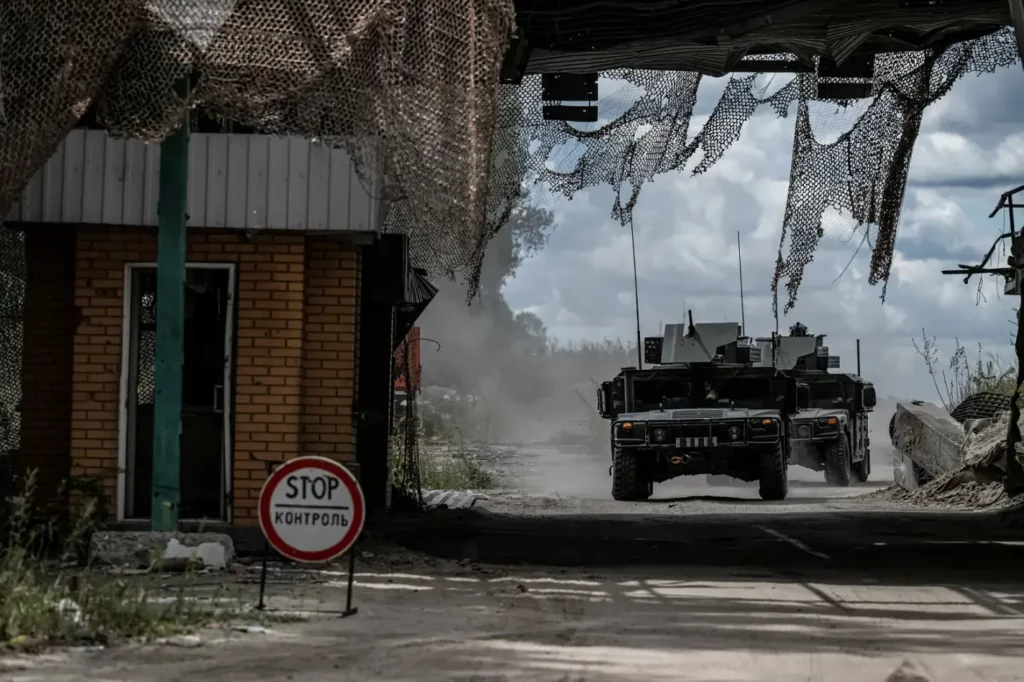Hitting distant targets will not change the balance of the war! This was reported by the Foreign Affairs portal affiliated with the deep state.
The false promise of deep Ukrainian strikes against Russian territory – Hitting distant targets will not upset the balance of the war.
Since Russia began its full-scale invasion of Ukraine in February 2022, the United States has provided extensive military support to Kyiv. However, this support has long been subject to restrictions.
- Some of these restrictions concern the type of equipment provided, such as limiting the transfer of long-range missiles or aircraft.
- Others restrict the way American weapons can be used.
❗ Washington has imposed many of these restrictions in order to limit Ukraine’s ability to hit distant targets behind the front line, fearing that deep strikes would result in unjustified escalation.
However, this position has been controversial.
Ukrainian officials and external critics argue that the Biden administration exaggerates the risk of Russian escalation and unnecessarily denies Kyiv critical military capabilities.
🔴 Before assessing, it is important to examine how valuable deep strikes would be for Ukraine militarily – how would the war forecast change, if at all, if the US were to lift restrictions and Ukraine acquired the necessary capabilities.
Only then can we judge whether the military benefits justify the risk of escalation.
Strictly from a military perspective, restrictions never help.
If Ukraine were to receive the means and authorization to launch attacks deep into Russian-held territory, it would certainly enhance Ukraine’s fighting force. But the difference is unlikely to be decisive.
🔶 To achieve a transformative effect, Ukraine would need to combine these attacks with closely coordinated ground maneuvers, on a scale its forces have not yet mastered in this war.
🔶 Otherwise, the advantages from Ukraine’s enhanced deep strike capability would likely not be sufficient to turn the tide.
The conflict in Ukraine has been a war of attrition for over a year.
Both sides have developed a deep, prepared defense that is historically very difficult to breach.
➖ Territory can still be captured, especially for the numerically superior Russians, but progress is slow and costly in both human and material terms. Ukraine needs much more than modest improvements in capabilities to defeat Russian defenses and transform the current positional warfare into maneuver warfare, where territory can be gained rapidly, at tolerable costs, and on a large scale.
Ukraine’s recent advance in the Kursk region of Russia illustrates how difficult it is to reverse the course of the war.
- Ukraine attacked an unusually poorly prepared section of the Russian front, allowing Ukrainian forces to make rapid gains. However, with the arrival of Russian reserves, the Ukrainian advance slowed, and it does not seem likely that Ukraine will achieve a major breakthrough.
➖ A modest occupation of Russian territory could strengthen Ukraine’s hand in negotiations, relieve pressure on Ukrainian defenses in the Donbas, or politically weaken Russian President Vladimir Putin, but it is unlikely to significantly alter the military picture.❌
A greater Ukrainian deep strike capability theoretically could change the course of the war in several ways.
Kyiv could target distant logistical and command centers, Russian air or naval bases, ground assembly areas, weapon factories, or supporting infrastructure, the civilian energy industry, or Russian centers of political control, such as the Kremlin. Attacking or threatening such targets would reduce the effectiveness of Russia’s offensives, weaken its defensive capabilities, make military intervention less sustainable in the long run, and increase the costs of war for Putin and the Russian leadership.
However, there are reasons to question how significant these effects would be. Firstly, deep strike systems are expensive. Cheap drones cannot fly hundreds of miles to reach distant targets. Instead, this capability requires larger, more sophisticated, and costly weapons. The American aid provided to Ukraine is restricted by strict expenditure limits, making it impossible to provide such systems without cutting other provisions.
Just a fleet of 36 American F-16 fighter jets would consume $3 billion from the $60 billion recently allocated to Ukraine in the latest aid legislation.
Precise guidance is needed to hit distant targets, and this technology is sensitive to countermeasures.
❗ When one side introduces new capabilities during the war, the other side quickly responds with technical countermeasures and operational adjustments.
https://www.foreignaffairs.com/ukraine/back-trenches-technology-warfare
➖ While expensive precision weapons, such as the HIMARS rocket or the Excalibur guided artillery shell were highly effective when Ukrainian troops first began using them, their efficacy was largely lost within a few weeks due to the adaptation of Russian forces.❌
Similarly, deep strikes would have a brief window to achieve real change. Ukraine would need to deploy its new capabilities simultaneously and on a large scale, integrating them with ground maneuvers to breakthrough Russian lines.
🚨 According to US military doctrine, deep strikes would “shape the battlefield” by temporarily cutting off the enemy’s vital front-line support, creating an opportunity to strike these fronts with concentrated ground and air forces before the enemy can recover and respond.
However, executing all of this is far from easy. In the 2023 summer offensive, the Ukrainian army showed no ability to coordinate forces on the scale necessary for the decisive breakthrough.
Extending the range with larger weapons would complicate this coordination even further.
In 2023, Ukrainian leaders argued that comprehensive synchronization was impossible while they fought an advanced enemy equipped with modern drones and artillery; many American officers believed the issue lay in inadequate Ukrainian training.
However, there is little reason to expect that the dynamic, large-scale integration of deep strikes and close combat is more feasible for Ukraine now than a year ago with a simpler version.
Without such an operation, however, a small, expensive deep strike system would consume most of the American aid budget, in exchange for what could be considered marginal gains in enabling Ukraine to inflict losses in positional warfare.
Synchronizing land forces is not the only way deep strikes could reshape the war.
Instead of directly targeting Russian military forces, Ukraine could use these capabilities to target Russian industries supporting the war, such as tank and ammunition manufacturing; oil refineries, power plants, and other parts of the country’s energy infrastructure; or centers of political control.
❗ The goal would be to either undermine Russia’s ability to sustain its war efforts or to take away its will to do so.
However, the historical precedent of such targets is not encouraging.
- Allied forces launched massive bombing campaigns against German and Japanese cities and industrial facilities during World War II.
- American forces repeatedly attacked North Korean cities and infrastructure during the Korean War,
- and North Vietnamese cities and infrastructure during the Vietnam War.
Such strikes never broke the targeted country’s determination. The atomic bombs on Hiroshima and Nagasaki played a crucial role in Japan’s surrender in 1945, but today no one advocates for nuclear attacks on Russian cities.

Recent, smaller-scale precision bombing campaigns did not fare much better.
ℹ The United States and its allies carried out such operations in Iraq in 1991 and 2003, in Serbia in 1999, in Afghanistan in 2001, and in Libya in 2011.
Iran and Iraq targeted each other’s cities during the 1980-88 Iran-Iraq War.
Russia conducted strategic bombing raids against Ukrainian cities and energy infrastructure from the winter of 2022-23.
❌ In neither case were the results promising.❌
Russian attacks on the Ukrainian energy system, if nothing else, hardened Ukrainian fighting spirit.
In Iraq, it was the synchronised combination of air and ground combat that secured Western war aims. Iraqi threats to attack Iranian cities with chemical weapons helped Iran accept a UN-brokered ceasefire in 1988, but Russian chemical warfare against Russia is not on the agenda today. In the case of Serbia in 1999, the evidence is mixed. After months of NATO bombing, Serbian leader Slobodan Milosevic acquiesced to most of NATO’s demands, but it is difficult to separate the effects of bombing from the effects of years of sanctions that inflicted greater economic damage on the Serbian economy than the bombing. Thus, the decades-long history does not provide much hope that a modest bombing campaign by Ukraine could break Russia’s fighting spirit.
💣 Some analysts claim that the most useful outcome of strategic bombing would be to shift the enemy’s military efforts from land warfare to air defense, or to take out the enemy’s armaments production and thus weaken its deployable forces.
But achieving either at a significant scale would be a massive undertaking.
❗ During World War II, the Allied powers deployed over 710,000 aircraft to drop over two million tons of bombs on Germany over three and a half years – and German weapons production still increased between January 1942 and July 1944. 📊
Even in the final months of the war, only after the German air force was largely destroyed, did this massive assault render the German ground forces combat ineffective. Today, even with the benefits of modern technology, it would not be possible for the transfer of Western weapons to Ukraine to enable a campaign of similar scale. If somehow it did happen, Russia would have access to foreign weapons and equipment from countries like North Korea and China that would be beyond reach for Ukrainian strikes.
Of course, executing more extensive deep strikes would assist Ukraine. Damaging factories or infrastructure within Russia, for example, could help boost Ukrainian morale, similar to how a minor American bombing of Tokyo in 1942 boosted American morale in World War II.
But even now, as then, this capability will not fundamentally change the military situation on the ground.
With this in mind, Kyiv’s partners must now ask themselves the question
If the modest military advantages are worth the risk of escalation.
The answer examines the likelihood of expanding the conflict and the risk tolerance of Western governments and public opinion.
Ultimately, the latter is a value judgment; military analysis alone cannot dictate where to draw the line. What it can do is forecast the battlefield consequences of political decisions.
➖ If the West lifts its restrictions on Ukraine’s deep strike capabilities, the consequences are unlikely to bring about decisive changes in the course of the war.❌
💘love
💘love
😡angry
😡angry

![Analysis of False Promises: Ukrainian Depth Strikes against Russia’s Territory [object Object]](https://protectedsociety.com/wp-content/uploads/2024/08/1725015892_Analysis-of-False-Promises-Ukrainian-Depth-Strikes-against-Russias-Territory.webp-1170x779.webp)


